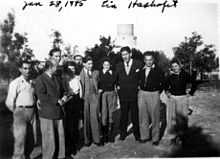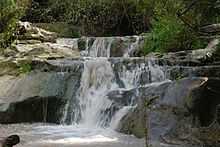Ein HaShofet
| Ein HaShofet עֵין הַשּׁוֹפֵט | |
|---|---|
 Ein HaShofet | |
| Coordinates: 32°35′45.24″N 35°6′3.96″E / 32.5959000°N 35.1011000°ECoordinates: 32°35′45.24″N 35°6′3.96″E / 32.5959000°N 35.1011000°E | |
| Grid position | 160/222 PAL |
| District | Northern |
| Council | Megiddo |
| Region | Ramat Menashe |
| Affiliation | Kibbutz Movement |
| Founded | 5 July 1937 |
| Founded by | Hashomer Hatzair |
| Population (2008) | 759 |
| Name meaning | Spring of the Judge |
| Website | www.keh.co.il |
Ein HaShofet (Hebrew: עֵין הַשּׁוֹפֵט, lit. Spring of the Judge) is a kibbutz in northern Israel in the Hills of Ephraim. Located in the Ramat Menashe region around 30 km from the city of Haifa, close to Yokneam, it falls under the jurisdiction of Megiddo Regional Council. In 2008 it had a population of 759.
Etymology
"Ein HaShofet" translates literally as "Spring of the Judge", with this judge being United States Supreme Court Justice Louis D. Brandeis (1856-1941), the first Jew to hold the aforementioned position, selected for his leading role in the American Zionist movement. There is a flowing spring nearby the kibbutz.
History

Ein HaShofet was first settled on 5 July 1937 with the settlers living on the nearby hill of Ja'ara for one year before moving to the final and current location of the kibbutz. Prior to the settling at Juara, the kibbutz's founders stayed for five years in Hadera, where the group was created by joining two Hashomer Hatzair groups, one from Poland (including Aharon Efrat, later a member of the Knesset) and one from North America, consisting the first Hashomer Hatzair group from North America. The kibbutz's foundation was a part of the Tower and stockade settlement drive.
The area was used by Arab "gangs" and the settlers had to defend themselves against armed attacks on a nightly basis. This was in the middle of the 1936–1939 Arab revolt in Palestine, known to the Jews of the time as the "disturbances." [1]
From 1938 onwards the hilltop site and stone house of Juara were used by the Haganah, the main Jewish underground militia, and later by the Israeli army and is now hosting a museum of the Haganah.,[2][3]
Despite a lack of water and hilly difficult reclamation, ten years later, with a population of 450, they "were a successful mixed hill farm with orchards, dry cereals, dairy products, sheep herding and chicken farming.".[1]
During the Israel's War of Independence the settlers helped to defeat Kaukji's forces after their April 1948 attack on Mishmar HaEmek.[1]
Demographics
At the end of 2003, the kibbutz was home to 688 people: 455 kibbutz members and candidates for membership, 160 children under 18 years of age, 20 soldiers, and the remaining 53 ulpanists, volunteers and non-member residents.
Economy

The main income source of Ein HaShofet today is its four factories, three of which are located in the kibbutz and one in the USA;
- Eltam, the kibbutz's largest employer; a company founded in 1967 as "Ein Hashofet Electric Industries" which today manufactures various components for electric devices, prominently light fixtures.
- Mivrag; founded in 1950 and manufactures various small metal objects, mainly screws, in cold forming processes.
- MAG EH; founded in 1999 and manufactures specific components for the automobile industry. It has an American division, MAG USA, which was founded in 2001 and is located in Knoxville, Tennessee.
The kibbutz also retains some agriculture as a secondary industry as a source of income. Agriculture here encompasses both produce and livestock and is split into six branches
- A dairy was created when Ein HaShofet was settled in its final location in 1938. Today it holds 270 cows which give around 3 million liters of milk per year.
- Beef cattle were first farmed at Ein HaShofet in the mid-1950s to exploit those surrounding lands which were unfit for crops. Today the branch is joined with that of neighboring kibbutz Mishmar HaEmek, with Ein HaShofet possessing 73% of the 750 cows.
- The kibbutz has an Avocado plantation which covers around approximate 360 dunams (360,000 m²) around the kibbutz.
- Chicken farms, which since 1971 serve solely for meat, today produce 2300 tons per year.
- A cattle fattening facility which fattens 1,500 cows per year services both the kibbutz's herd and imported cattle from Australia, Poland and those from within Israel itself.
- Arable farming encompasses approximately 4000 dunams (4 km²), with the crops changing according to market demands and weather conditions, though chiefly growing wheat and cotton.
Ein HaShofet also has a long standing ulpan course, with over 100 ulpan groups since 1951. Benjamin Urrutia is amongst the alumni.
References
External links
| Wikimedia Commons has media related to Ein HaShofet. |
| ||||||||||||||||||